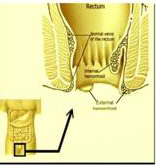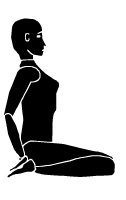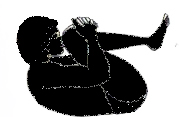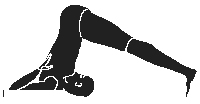Introduction

Piles may also develop by frequent use of laxatives and long hours sitting on much hard or soft surface. Hurried eating without proper mastication with disturbed mind, excessive use ofnon-veg food items, alcohol, tea and coffee etc. disturb the entire digestive system and lend sluggishness to digestive organs and ultimately result in Piles. Hemorrhoids are balloon kind of swelling in the veins near the anus. It can be internal or external. External piles are not harmful but they cause pain at the time of excretion. Internal piles are a great cause of trouble as they cannot be dealt with immediately. Yoga helps greatly for the treatment of dry internal piles in the body. Piles can be either caused due to heredity or at times due to sexual troubles or over indulgence. Lack of physical activity too can be a cause of piles. Constipation and mal functioning of liver can cause piles which may trouble the individual for a long period of time.
Yoga and Piles
Yoga can be very beneficial in relieving bowel troubles. As a first line of defense, it might be useful to focus asanas on the mid-section. Yoga helps in the removal of the toxins in the body which can give a free and active feeling to the body and once the toxins are out from the body, it helps to restore the normal balance of the body and provide freedom from the pain caused due to piles. Piles may cause back pain in several individuals because of its critical position in the body. Yoga exercises can help greatly in the treatment of piles and the back pain. The stretch and strain provided as a part of yoga helps to regulate the body and provide freedom from the acute pain caused in the body. Also adding some of the elements of a yogic lifestyle may help with your bowel difficulties. One of the key elements of the yogic lifestyle is strict vegetarianism. Various asanas can be used for the treatment of piles and a few which have guaranteed results like sarvangasana (shoulder stand), tadasana (mountain pose), surya namaskar (sun salutation) and a few quite challenging poses like shirshasana (head stand).YOGA POSES FOR PILES
Palm Tree Pose
Tala" means "palm tree" in Sanskrit. In this posture, the body is held upright like the trunk of a palm tree. Hence the name. By practicing this asana, the body becomes well-built, well-proportioned, nimble and agile. It expands the ribcage and increases the capacity of the lungs. It firms up the respiratory muscles and the muscles of his neck lower back, abdomen and pelvis.Shoulder Stand Pose
The Shoulder Stand stimulates and rejuvenates your entire body. In this exercise, you build up both power and a new structure in your back and you relax tension in well-known stress areas like the neck and the lower back. The muscles of your lower back get stronger, the chest and shoulders can move more freely and the back gets straighter.Camel Pose
Camel pose, is also known as Ushtrasana. After doing the Camel Pose, you can feel the stretch in the spinal chord, neck, abdomen, and on the shoulders. The camel pose focuses on Vishudhi Chakra and Svadhishthan.The Boat Pose
Doing this pose will rapidly increase strength and muscle tone in your midsection. Keep challenging yourself to stay in this pose longer. If you find the stimulation of the midsection becoming intense, just persist with it, knowing your mind has ultimate control over the body.Wheel Pose
This exercise strengthens the power of your legs, arms and wrists and makes your back and spinal column supple and flexible. In this exercise the front part of the body is stretched and the back side of the body is bent.Mountain Pose
The Mountain Posture (whose original Indian name is Parvatasana) in Yoga is suitable for reducing arthritic aches in the shoulders as well as for stretching the upper body. The posture gets its name because the person performing it resembles a Mountain with the raised arms denoting the peak. The mountain pose is the pose that you usually start out with when you are doing standing postures, and it is one that you return to in between the postures.The Standing Forward Bend
This pose aids in digestion and is restorative. It frees the rib cage allowing for improved breathing. It aids in mental concentration and helps to revive mental and physical exhaustion. The heartbeat is slowed and the lower back is strengthened and pressure is removed from the lumbar region. It increases flexibility while strengthening and developing the hamstrings. It also helps to strengthen the feet and ankles while realigning the entire body.Wind Relieving Pose
Wind relieving posture improves digestion and elimination as well as stretching and healing the low back and spine. This pose can relieve unwanted gases from your body. The excess gas would be removed from the stomach and the digestive system will be improved.YOGA ASANAS FOR PILES
PASCHIMOTTANASANA

Steps
- This posture involves stretching of the posterior muscles of the body.
- While sitting, stretch your legs forward and keep them close to each other. Bend a little forward, make hooks of your fingers and hold the big toes on the respective sides.
- While exhaling, bend forward stretching the trunk along the thighs. Rest your on the knees, which should be kept straight.
- Gradually, the tense muscles can be made supple for securing the complete posture. Inhale and return to the original position.
VAJRASANA

Steps
- Keep the soles of the feet on both sides of the anus, i.e., place the thighs on the legs one over the other and the soles on the buttocks. The calves must touch the thighs.
- The part from the toe to the knee should touch the ground. The whole burden of the body is put on the knees and ankles.
- The beginning of practice you may feel a slight pain in the knee and ankle-joints but it passes off very quickly.
- After fixing the feet and the knees, put both the hands straight on the knees.
- Keep the knees quite close.
- Sit like this keeping the trunk, neck and head in one straight line.
MAYURASANA

Steps
- Sit on the floor with your knees about 12 inches apart
- Now kneel down in the same position.
- Stretch the fingers of the hand. The fingers shall remain stretched pointing backwards.
- Now place the hands, palms on the floor between the knees and with the wrists in front.
- Place your elbows gently on either sides of the navel.
- Now slowly bend forwards until the abdomen is resting on the elbows.
- At first come forwards and then begin raising the upper part of the body.
- Now slowly and steadily raise the body and the legs in one horizontal position with the legs outstretched forming the letter �V�.
- The whole of the horizontal body is now resting on the hands with the forearms vertical.
- Hold this posture for a while or few seconds.
- Return to the original position. Then slowly fold your legs and place the knees on the ground.
- Now raising your hands from the ground sit on your soles.
PAVANMUKTASANA

Steps
- Keep your hands by the side of your body in a supine position. While inhaling, raise both your legs to 90 and bend them at the knees.
- Make a finger-lock with both your hands around them, a little below the knees. While exhaling, bring your thighs close to the chest by contracting the abdominal muscles. Maintain this posture for a few seconds.
- Then return to the original posture in the reverse order as Ardha Pavan Muktasana. Repeat the asana three to four times.
HALASANA

Steps
- Lie on your back inhale to your fullest and lift your legs and trunk first to 30 degree, then 60 degree and finally 90 degree just as in sarvangasana, then take your legs back of your head making it 120 degree and beyond, this process should be done while exhalaling.
- Now rest the toes on the ground behind the head and breath normally, you can use hands on the back for support but ideally both in sarvangasana and halasana hands should be on flooe, palms touching the floor.
- When acquiring the posture of halasana the legs should be at 30 degree from the floor.
- Same process is done in reverse order while returning to normal position.
SARVANGASANA

Steps
- Lie on your back with legs and arms straight, feet together and palms on the floor beside your body. While exhaling, raise your legs slowly upto 90 and then the whole body and the rest your weight on the arms so that the chin touches the jugular notch.
- Bring the arms and hands to support your body at the hip region (fingers at the back and thumb in front of the body). The entire weight of your body rests on the head, neck and shoulders while the arms are used for balancing.
- Keep the trunk, legs and hips in a straight line and as vertical as possible Focus your eyes on your toes, with your chin pressed against the chest. Retain the posture for one for three minutes.
- While exhaling, return to the lying position by bringing the leg backward and releasing the hands and the palms.
Diseases Related to Scorpio |
||


